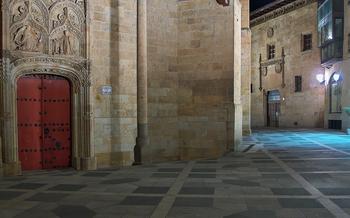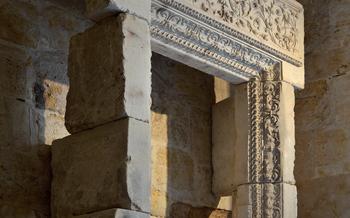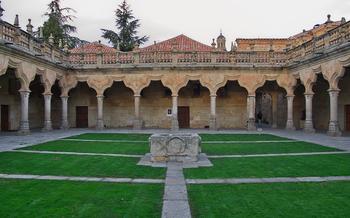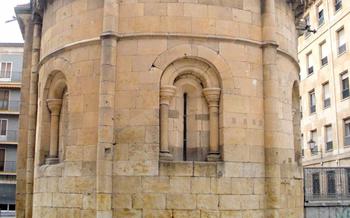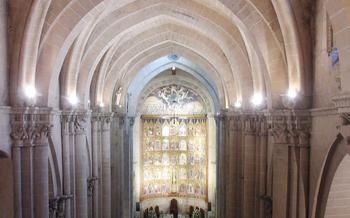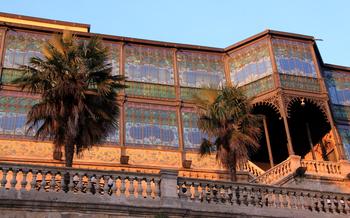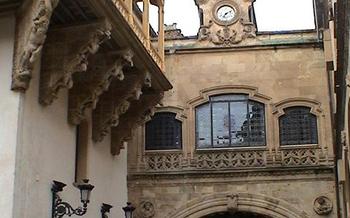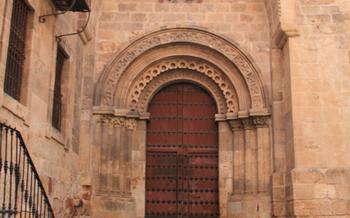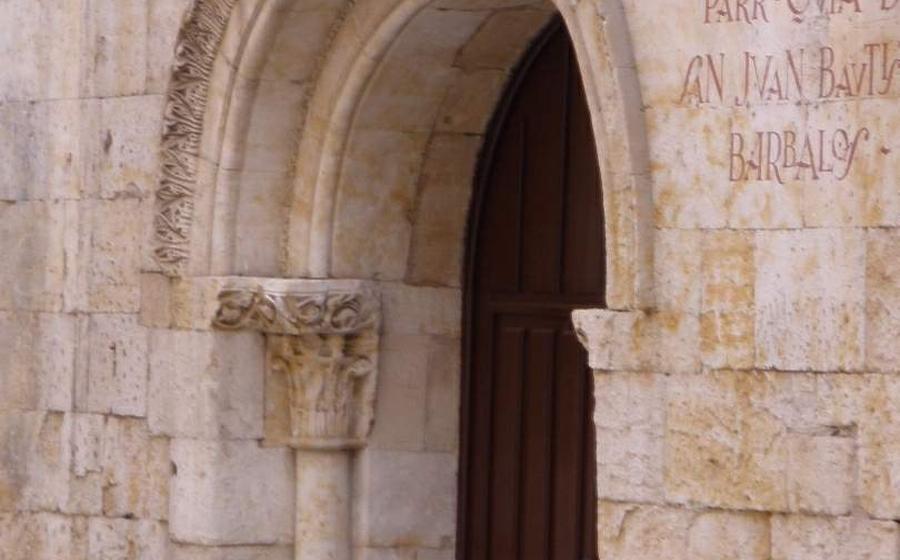
Church of San Juan de Barbalos
- Location and Accessibility
- Historical Overview: The Church's Past
- Architectural Highlights: Exploring the Church's Design
- Artistic Treasures Within: Discover the Church's Art
- Unique Elements: Distinctive Features of the Church
- Religious Significance: A Place of Worship and Pilgrimage
- Visiting Hours and Admission Fees
- Dress Code and Respectful Behavior
- Photography and Social Media Etiquette
- Nearby Attractions and Points of Interest
- Suggested Length of Visit: How Much Time to Allocate
- Local Cuisine and Dining Recommendations
- Accommodation Options for Visitors to Salamanca
Location and Accessibility
The Church of San Juan de Barbalos is situated in the heart of Salamanca's historic center, within easy reach of other notable landmarks. Its exact address is Calle Zamora, 1, 37002 Salamanca, Spain. Visitors can conveniently access the church using various modes of public transportation. The nearest bus stop, "Plaza Mayor," is just a short walk away, with buses passing regularly from different parts of the city. For those arriving by car, there are several parking options in the vicinity. The underground parking at Plaza Mayor offers a convenient and secure option. Alternatively, street parking is available on nearby streets, but it may be limited during peak tourist seasons.
Historical Overview: The Church's Past
The Church of San Juan de Barbalos has a rich and storied past that dates back to the 12th century. It was founded by the Knights Templar, a powerful religious order that played a significant role in the Reconquista, the Christian campaign to reclaim the Iberian Peninsula from Muslim rule. The church was initially conceived as a Romanesque structure but underwent several renovations and additions throughout the centuries, reflecting the evolving artistic and cultural trends of the time.
During the Middle Ages, the church served as an important center of religious devotion and pilgrimage. It was dedicated to Saint John the Baptist, a revered figure in Christianity, and attracted pilgrims from all over the region. The church also served as a meeting place for the Knights Templar, who used it to plan and coordinate their military campaigns.
In the Renaissance and Baroque periods, the church underwent significant architectural and artistic transformations. Gothic elements were incorporated into the original Romanesque design, such as the pointed arches and ribbed vaults that grace the interior. The church was also embellished with elaborate Baroque decorations, including intricate carvings, gilded altars, and colorful frescoes. These additions reflected the growing affluence and artistic patronage of the period and transformed San Juan de Barbalos into a stunning example of mixed architectural styles.
Architectural Highlights: Exploring the Church's Design
The Church of San Juan de Barbalos showcases an intriguing blend of Romanesque and Gothic architectural elements, making it a visual masterpiece. The exterior facade captivates with its Romanesque features, including a beautifully carved tympanum depicting scenes from the life of Christ. Intricate carvings and moldings adorn the facade, adding depth and texture to the church's exterior.
Stepping inside, visitors are greeted by a spacious interior characterized by a nave, aisles, and an apse. The nave is supported by massive pillars with intricate capitals, creating a sense of grandeur and solemnity. The ribbed vaults overhead, a characteristic of Gothic architecture, add to the visual appeal of the interior.
One of the most striking features of the church is its bell tower. This distinctive Romanesque tower stands tall, dominating the skyline of Salamanca. Its sturdy construction and intricate carvings showcase the architectural prowess of the time. The tower serves as a landmark for the city, visible from various vantage points.
Exploring the Church of San Juan de Barbalos is a journey through architectural history, where Romanesque and Gothic elements harmoniously coexist, creating a captivating and awe-inspiring space.
Artistic Treasures Within: Discover the Church's Art
The Church of San Juan de Barbalos is a treasure trove of artistic wonders that captivate the eyes and inspire the soul. The most striking feature is the magnificent altarpiece, a masterpiece of the Renaissance period. Crafted with intricate detail and vibrant colors, it depicts scenes from the life of Saint John the Baptist, the church's patron saint. The altar becomes a canvas for storytelling, narrating biblical episodes with a realism that transports visitors to another era.
Adorning the walls of the church are exquisite murals and frescoes. These artworks showcase the talent of medieval and Renaissance artists, bringing to life biblical stories and religious figures with their expressive brushstrokes. Each mural tells a unique tale, inviting visitors to contemplate the rich tapestry of Christian history and tradition.
The beauty of the church is further enhanced by its stained glass windows. These intricate creations, with their kaleidoscope of colors, cast a warm and ethereal glow within the sacred space. The windows depict religious scenes, symbolic motifs, and intricate patterns, creating a harmonious interplay of light and color that inspires awe and reverence.
Unique Elements: Distinctive Features of the Church
The Church of San Juan de Barbalos boasts several distinctive features that set it apart from other Romanesque churches in Salamanca. One notable element is the presence of Mozarabic influences, particularly in the intricate carvings and decorative elements. The Mozarabs were Christians who lived under Muslim rule in the Iberian Peninsula, and their artistic style blended Islamic and Christian motifs. These influences can be seen in the church's horseshoe arches, geometric designs, and the use of colorful tiles.
Another unique aspect of the church is its cloister, a serene and peaceful courtyard surrounded by arcades. The cloister features beautiful Romanesque arches and columns, as well as a well-preserved garden. It serves as a place for contemplation and reflection, offering a tranquil oasis amidst the bustling city.
Finally, the church houses a small museum, which showcases a collection of sacred art and historical artifacts related to the church's history. Visitors can admire religious sculptures, paintings, and vestments, as well as learn more about the church's founding and its role in the community. The museum provides a deeper insight into the spiritual and cultural significance of this remarkable church.
Religious Significance: A Place of Worship and Pilgrimage
The Church of San Juan de Barbalos holds immense religious significance, not only for the city of Salamanca but for the entire region. It is a designated Catholic pilgrimage site, attracting devout believers from far and wide. The church is dedicated to Saint John the Baptist, who is revered as the patron saint of the city. Visitors can marvel at the stunning altarpiece depicting scenes from the saint's life and teachings. Throughout the year, the church hosts various religious festivals and events honoring Saint John, drawing large crowds of pilgrims and worshippers. These celebrations showcase the deep-rooted faith and devotion of the local community, providing a glimpse into the rich religious heritage of Salamanca.
Visiting Hours and Admission Fees
Visiting the Church of San Juan de Barbalos is a rewarding experience that allows visitors to delve into its rich history, admire its architectural marvels, and appreciate its artistic treasures. To ensure a smooth and enjoyable visit, it is important to be aware of the church's visiting hours and admission fees.
Visiting Hours:
The Church of San Juan de Barbalos welcomes visitors from Tuesday to Sunday, offering ample opportunities for exploration and worship. The church's opening hours are typically as follows:
- Tuesday to Saturday: 10:00 AM to 1:00 PM and 4:00 PM to 7:00 PM
- Sunday: 12:00 PM to 2:00 PM
It is advisable to plan your visit accordingly to avoid any inconvenience. Kindly note that the church may occasionally have special events or services that may affect its regular visiting hours, so checking the official website or contacting the parish office in advance is recommended.
Admission Fees:
Admission to the Church of San Juan de Barbalos is generally free of charge, allowing visitors to explore its wonders without any financial burden. However, donations are gratefully accepted and encouraged to support the church's ongoing maintenance and preservation efforts. Visitors are welcome to contribute any amount they deem appropriate to help ensure that this historic treasure remains accessible to future generations.
Dress Code and Respectful Behavior
Appropriate Attire: When visiting the Church of San Juan de Barbalos, it is important to dress respectfully, adhering to the sacred nature of the site. While there is no strictly enforced dress code, visitors should avoid wearing revealing or overly casual clothing. Modest attire, such as long pants or skirts and shirts that cover the shoulders, is recommended.
Silence and Reverence: The church is an active place of worship, and visitors are expected to maintain a respectful and quiet demeanor. Avoid loud conversations, laughter, or any behavior that may disrupt the tranquility of the space. Photography and videography are permitted, but using flash or tripods is generally discouraged.
Remember, the Church of San Juan de Barbalos is a place of spiritual significance for many people. By dressing appropriately and behaving respectfully, you can contribute to the serene and reverent atmosphere of this historic site.
Photography and Social Media Etiquette
Photography Guidelines: When visiting the Church of San Juan de Barbalos, it is important to be mindful of photography etiquette. While capturing the beauty of the church through photographs is encouraged, visitors are kindly requested to respect the sanctity of the space. Using flash photography is strictly prohibited, as it can damage the delicate artworks and disturb ongoing religious services. Tripods and selfie sticks are also not permitted within the church premises.
Social Media Sharing: Visitors are welcome to share their experiences and photographs of the church on social media platforms. However, it is crucial to do so responsibly and respectfully. Always seek permission from individuals appearing in your photographs before sharing them online. Additionally, be mindful of the privacy of other visitors and avoid capturing images that may be intrusive or disrespectful. When sharing your photos, use relevant tags and hashtags to help others discover this hidden gem.
Nearby Attractions and Points of Interest
After exploring the Church of San Juan de Barbalos, take some time to venture into the heart of Salamanca and discover its vibrant atmosphere and rich cultural heritage. A short walk from the church, you'll find the Plaza Mayor, the city's bustling main square. Marvel at its grand architecture, soak in the lively ambiance, and perhaps enjoy a coffee or a traditional Spanish dish at one of the many restaurants and cafes that line the square.
For a taste of academic history and architectural splendor, head to the University of Salamanca, one of the oldest and most prestigious universities in the world. Explore its historic courtyards, admire its intricate facades, and learn about its contributions to education and scholarship.
Art enthusiasts should not miss the Casa Lis Art Nouveau Museum, a short walk from the university. This museum showcases a stunning collection of Art Nouveau artifacts, including furniture, ceramics, jewelry, and paintings. Immerse yourself in the world of this artistic movement and discover the unique blend of elegance, nature, and symbolism that characterizes Art Nouveau.
Suggested Length of Visit: How Much Time to Allocate
When planning your visit to the Church of San Juan de Barbalos, it is important to allocate sufficient time to fully appreciate its architectural beauty, artistic treasures, and historical significance. A recommended duration for your visit is approximately one to two hours. This will allow you to explore the church's exterior and interior at a leisurely pace, admire the intricate carvings and artwork, and immerse yourself in the serene atmosphere. If you are particularly interested in the church's history and religious significance, consider joining a guided tour, which typically lasts around 45 minutes to an hour. This will provide you with valuable insights into the church's past and its role in the community. Remember to factor in additional time if you plan to visit the on-site museum or attend a religious service.
Local Cuisine and Dining Recommendations
To fully immerse yourself in the local culture, be sure to savor the delectable cuisine that Salamanca has to offer. Indulge in traditional dishes such as hornazo, a savory pork and bread delicacy, or chanfaina, a hearty stew made with lamb or pork. Don't miss out on the opportunity to try cocido maragato, a traditional stew with chickpeas, meats, and vegetables.
For a delightful dining experience near the Church of San Juan de Barbalos, consider El Mesón de Gonzalo, known for its authentic Spanish cuisine and cozy ambiance. Alternatively, La Taberna del Alabardero offers a refined culinary journey with modern interpretations of traditional dishes.
Whether you choose to dine at a traditional tavern or a modern restaurant, Salamanca's culinary scene will tantalize your taste buds and leave you with lasting memories.
Accommodation Options for Visitors to Salamanca
When planning your trip to Salamanca, finding a comfortable place to stay is essential. The city offers a range of accommodation options to suit every taste and budget. For a truly immersive experience, consider staying in the heart of the historic center, where you'll be within easy reach of the Church of San Juan de Barbalos and other iconic landmarks. Numerous hotels, guesthouses, and apartments are available in this area, offering a blend of modern amenities and traditional charm.
Budget-conscious travelers can find affordable hostels and guesthouses that provide basic yet comfortable accommodation. For those seeking a more luxurious stay, several elegant hotels offer stunning views of the city and top-notch amenities. Whether you prefer a cozy boutique hotel or a spacious apartment with self-catering facilities, Salamanca has something to offer every traveler.
To make the most of your stay, consider booking your accommodation in advance, especially during peak tourist season. This will ensure you secure a room that meets your needs and preferences. Don't forget to check online reviews and ratings to find the best accommodation options that align with your travel style and budget.

